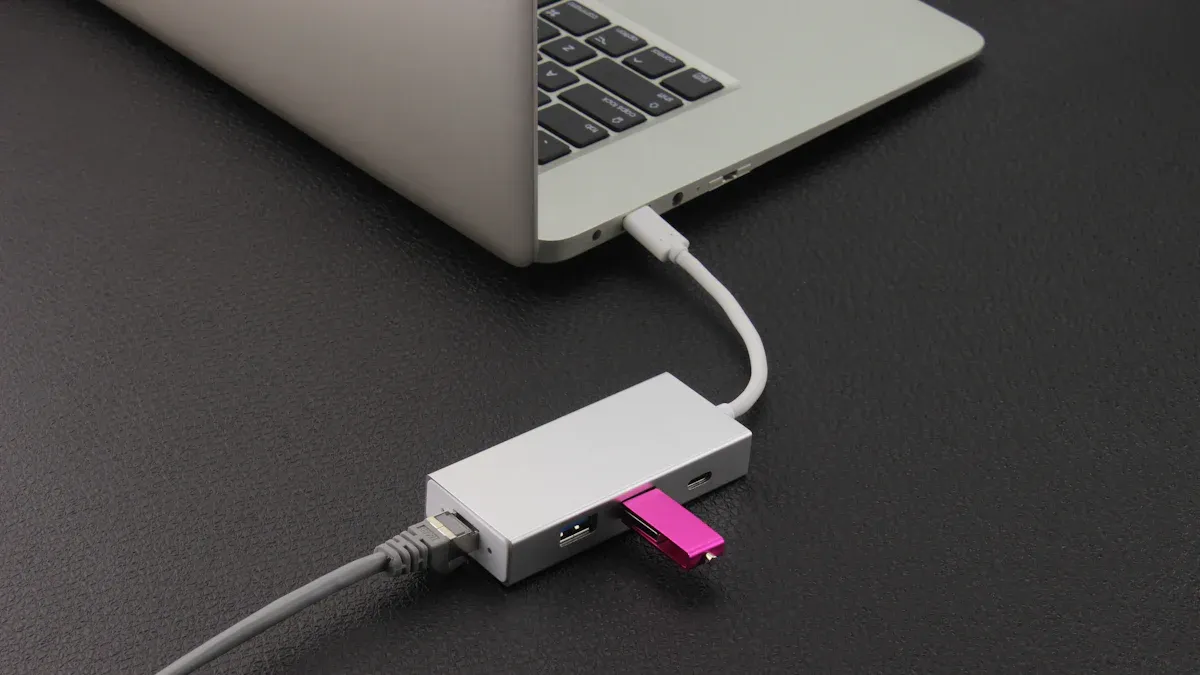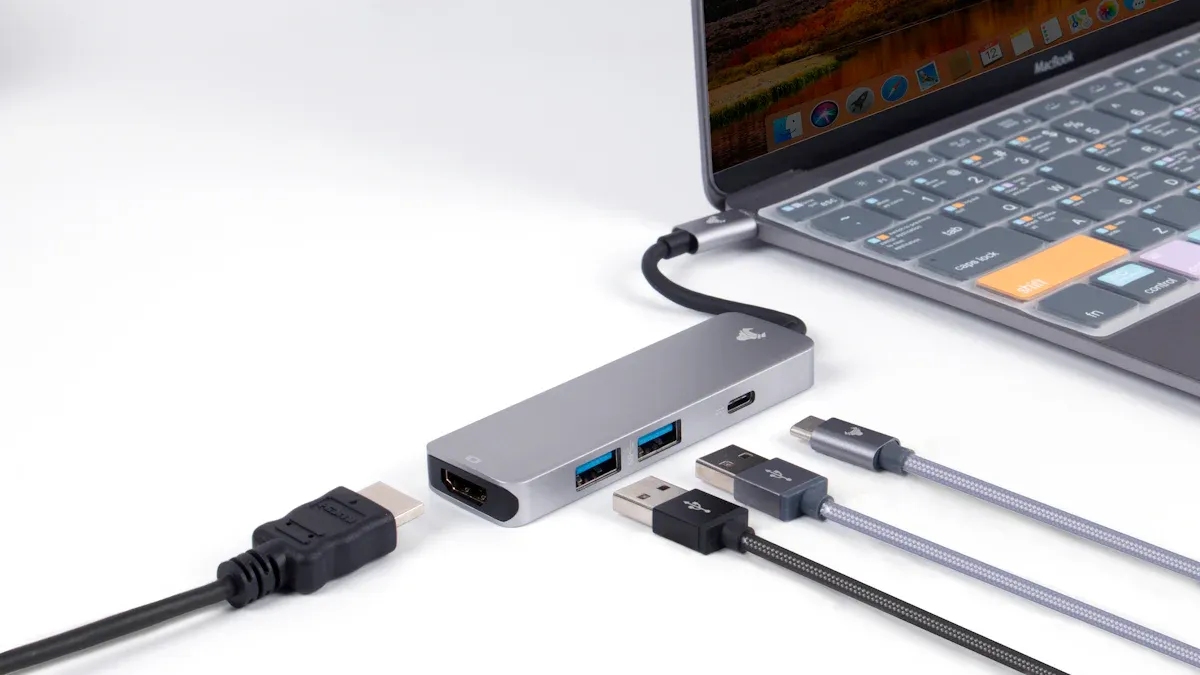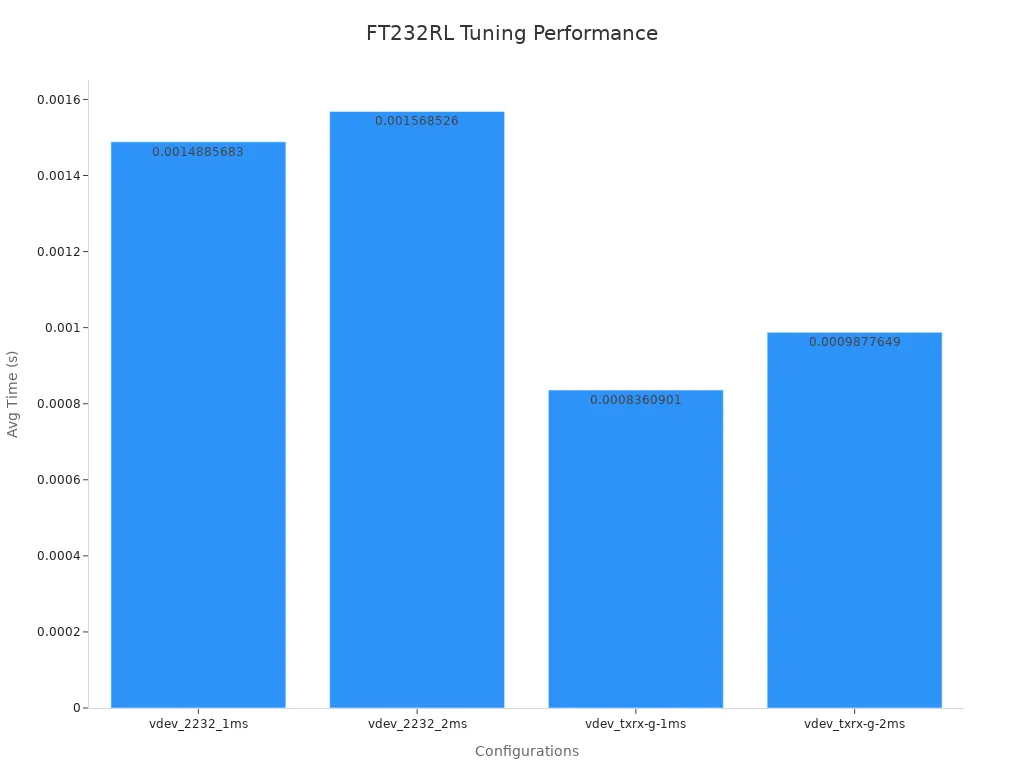Using FT232RL for Seamless USB to RS232 Communication

The FT232RL-REEL enables efficient USB to RS232 connected industrial equipment communications, making it a reliable tool for linking USB to RS232. It helps old devices work with modern USB connections easily. This chip simplifies data transfer and performs well in various applications. Its straightforward design and strong compatibility contribute to its popularity in industries. By using the FT232RL-REEL, you can enhance USB to RS232 communication, resulting in faster operations and reduced delays.
Key Takeaways
The FT232RL chip makes USB to RS232 connections simple. It helps connect new devices to older ones easily.
It works with many data speeds, from 300 baud to 3 Mbaud. This makes it useful for different industrial tasks.
It has built-in protections like surge and over-current safety. These features make it reliable in tough conditions.
You don’t need extra programming to use the FT232RL chip. This allows for quick setup and easy use in projects.
Updating drivers and firmware often keeps it working well. It also ensures it works with different operating systems.
Understanding the FT232RL Chip
Purpose and Functionality of the FT232RL Chip
The FT232RL chip acts as a link between USB and RS232 systems. It makes it easy to connect modern USB ports to older RS232 devices. This chip manages the USB protocol on its own, so no extra programming is needed. It helps transfer data smoothly between devices, making it very useful in industrial systems.
The FT232RL chip works with many data speeds, from 300 baud to 3 Mbaud. This makes it fit for different industrial uses. Its UART interface lets you adjust data bits, stop bits, and parity settings. This flexibility helps meet various communication needs. Whether you’re programming microcontrollers or connecting sensors, this chip is a dependable choice.
Feature | Description |
|---|---|
Single Chip Solution | Combines USB to serial data transfer in one chip. |
Integrated USB Protocol Handling | Manages USB protocol internally, removing the need for extra programming. |
Data Transfer Rates | Handles speeds from 300 baud to 3 Mbaud for RS232, RS422, and RS485. |
UART Interface | Supports 7 or 8 data bits, 1 or 2 stop bits, and multiple parity options. |
USB Compatibility | Works with USB 2.0 Full Speed and various host controllers. |
Applications | Converts USB to serial interfaces for easy device connection. |
Key Features That Make the FT232RL-Reel Ideal for Industrial Communication
The FT232RL-reel is great for USB to RS232 communication in industries. It offers fast data transfer, which is important for quick responses. The chip works well in tough conditions, ensuring steady performance.
One key feature is its ability to work with many devices. This makes it useful in different industrial setups. Its built-in power isolation keeps voltage stable, protecting sensitive equipment. The chip also has surge and over-current protection to guard against electrical damage.
Feature | Description |
|---|---|
Fast Communication | Transfers data quickly for faster responses. |
Stability | Works reliably in different environments. |
Compatibility | Supports many devices for flexible use. |
Power Supply Isolation | Keeps voltage steady for delicate equipment. |
Surge Protection | Shields devices from electrical spikes and shocks. |
The FT232RL chip supports USB 2.0 Full-Speed for fast data transfer. It also offers multiple modes like UART and Bit-Bang for different uses. With its built-in EEPROM, you can customize settings for your projects.
Benefits of Using the FT232RL as a USB to Serial Converter
Using the FT232RL chip as a USB to serial converter has many benefits. It makes connecting USB to RS232 devices simple, without needing extra hardware or software. The chip is strong and works well even in noisy environments. Its design reduces interference, keeping communication stable.
The FT232RL-reel supports high data speeds and protects against electrical issues. This makes it perfect for tasks needing speed and reliability. It also works with Windows, macOS, and Linux, making it easy to use in different systems.
Here are some main benefits of the FT232RL chip:
Ease of Use: Handles USB protocols itself, so no extra programming is needed.
Versatility: Works with different speeds and communication setups.
Reliability: Built-in protections ensure stable performance.
Customizability: You can adjust settings using the built-in EEPROM.
Wide Compatibility: Works with many devices and operating systems.
The FT232RL chip is often used for programming, connecting sensors, and linking industrial devices. It helps with data sharing and control, making it a key part of industrial communication systems.
Technical Specifications and Pinout

Overview of the FT232RL Chip's Technical Specifications
The FT232RL chip has strong features for USB to RS232 tasks. It works with USB 2.0 Full Speed, making data transfer smooth. It supports speeds from 300 baud to 3 Mbaud, fitting many industrial needs. The chip can handle temperatures from -40°C to +85°C, so it works in tough places.
Key specifications include:
Chipset: FT232RL by FTDI
USB Protocol: USB 2.0 Full Speed compatible
Baud Rates: 300 baud to 3 Mbaud
Serial Protocol: RS232
Power Supply: 5V via USB port
Current Rating: 50 mA operating, 70 mA maximum
Operating Temperature Range: -40°C to +85°C
These features make the chip reliable for industrial use, whether connecting sensors or programming microcontrollers.
Pin Configuration and Its Role in USB to RS232 Communication
The FT232RL chip's pins are important for USB to RS232 communication. Each pin has a job to help data and signals move smoothly between devices.
Pin Number | Name | Type | Description |
|---|---|---|---|
1 | VCC | Power | Supply voltage (5V from USB) |
2 | GND | Power | Ground connection |
3 | TXD | Output | Transmit Data (to serial device) |
4 | RXD | Input | Receive Data (from serial device) |
5 | RTS | Output | Request To Send (flow control) |
6 | CTS | Input | Clear To Send (flow control) |
7 | DTR | Output | Data Terminal Ready (modem control) |
8 | DSR | Input | Data Set Ready (modem control) |
9 | DCD | Input | Data Carrier Detect (modem control) |
10 | RI | Input | Ring Indicator (modem control) |
Use TXD and RXD pins to send and receive data. RTS and CTS help manage data flow. Modem pins like DTR and DSR handle handshake signals. This setup makes it easy to connect microcontrollers and RS232 devices.
Electrical Characteristics and Considerations for Industrial Use
The FT232RL chip's electrical features suit industrial settings. It uses 5V power from the USB port, so no extra power is needed. It uses 50 mA during normal work and up to 70 mA for heavy tasks.
RS232 needs at least +/-9V for signals. The chip handles this well, even in noisy areas. Its surge protection keeps devices safe from electrical spikes, improving reliability.
Think about the chip's temperature range when using it. It works well in extreme cold or heat, like in freezers or hot factories.
Tip: Always check voltage levels and pin setups to avoid errors and protect your devices.
Step-by-Step Guide to Using the FT232RL Chip
Setting up the FT232RL-reel for USB to RS232 communication
To use the FT232RL-reel for USB to RS232, follow these steps. First, connect the chip to your computer's USB port. The chip gets power from the USB, so no extra power is needed. Make sure the VCC and GND pins are connected properly for stable power.
Next, link the TXD (Transmit Data) and RXD (Receive Data) pins to your RS232 device. These pins move data between the USB and RS232. If flow control is needed, connect the RTS (Request to Send) and CTS (Clear to Send) pins. These help manage data flow for smooth communication.
After connecting the hardware, install the drivers for the FT232RL chip. FTDI offers drivers for Windows, macOS, and Linux. Once installed, the chip shows up as a virtual COM port on your computer. You can now use this port to talk to your RS232 device.
Tip: Check all connections before turning on the chip. Wrong wiring can harm the chip or devices.
Configuring the chip for optimal performance
To get the best performance, configure the FT232RL chip settings. Open the virtual COM port using terminal software like PuTTY or Tera Term. Adjust the baud rate, data bits, stop bits, and parity to match your RS232 device. The chip supports speeds from 300 baud to 3 Mbaud, making it flexible for many uses.
For advanced settings, use the chip's built-in EEPROM. This memory lets you save custom settings like device names and serial numbers. FTDI provides a tool called FT_Prog to program the EEPROM. This helps you fine-tune the chip for your needs.
Tests show how configurations affect performance. For example, the table below compares different setups:
Configuration | Entries Read | Avg Time (s) | Min Time (s) | Max Time (s) | Total Time (s) | Std. Dev (s) |
|---|---|---|---|---|---|---|
vdev_2232_1ms | 27649 | 0.0015 | 0.000003 | 0.0037 | 41.16 | 0.00036 |
vdev_2232_2ms | 24508 | 0.0016 | 0.000002 | 0.0038 | 38.44 | 0.00027 |
vdev_txrx-g-1ms | 47791 | 0.0008 | 0.000002 | 0.0030 | 39.96 | 0.00033 |
vdev_txrx-g-2ms | 59368 | 0.0010 | 0.000002 | 0.0041 | 58.64 | 0.00043 |

These results show why proper setup matters. For instance, the vdev_txrx-g-1ms setup had the fastest average time, making it great for high-speed tasks.
Note: If flow control fails, check the RTS and CTS pin connections. Wrong settings can cause data problems.
Best practices for integrating the FT232RL chip into industrial equipment
Follow these tips to use the FT232RL chip in industrial setups. First, use shielded cables to block electromagnetic interference (EMI). EMI is common in factories and can mess up data signals. Shielded cables keep communication steady.
Second, protect the chip and wires with a strong case. This keeps the chip safe from dust, moisture, and damage. Industrial areas can be rough, so a sturdy case is important.
Third, test the chip in real conditions. Check how it handles fast data and power changes. Testing helps you fix problems and improve performance.
Lastly, update the chip's firmware and drivers. FTDI often releases updates to improve the chip. Keeping it updated ensures smooth operation.
Tip: Write down your setup details. This helps solve problems and repeat the setup later.
Applications and Use Cases
Common industrial uses of the FT232RL chip
The FT232RL chip is important in many industries. It connects USB and RS232 devices, making it useful in automation, medical tools, and energy systems. Its compatibility and safety features make it reliable.
This chip is often found in USB-serial adapters. These adapters help old RS232 systems work with modern USB devices.
Studies show advanced adapters with this chip cost more due to their quality.
FTDI Chip, the maker of FT232RL, controls over 40% of the USB-serial IC market. This shows its value in industries like automation and healthcare.
Real-world examples of USB to RS232 use with the FT232RL
One project shows how the FT232RL chip helps USB to RS232 communication. A microcontroller sends data to a computer using UART/USB signals. The FT232RL chip converts these signals, ensuring smooth data flow. This proves its reliability in tough industrial settings.
Another example is an IoT energy monitoring system. The FT232RL chip changes RS485 signals into USB format. This allows an industrial Mini-PC to track energy use in real time. It helps save energy and cut costs.
Application | Description |
|---|---|
Industrial IoT energy monitoring | Uses the FT232RL chip to convert RS485 to USB for real-time energy tracking. |
Benefits of the FT232RL-reel for industrial communication
The FT232RL-reel has many benefits for industrial communication. It is stable and reliable, even in tough conditions. The chip supports fast data speeds, up to 3 Mbps. Official drivers make it easy to set up on different systems.
Benefit | Description |
|---|---|
Stability | Very reliable, even in demanding environments. |
Driver Support | Works with many systems, thanks to official drivers. |
Advanced Features | Includes auto baud rate detection and flow control. |
Fast Communication | Handles high speeds, up to 3 Mbps. |
Industrial Use | Perfect for industries needing strong and steady performance. |
Power Protection | Offers safety features like overvoltage protection. |
The FT232RL chip's strong design and useful features make it a top choice. It handles complex tasks well, keeping industrial systems running smoothly.
Troubleshooting and FAQs
Common issues with the FT232RL chip and their solutions
Using the FT232RL chip can sometimes lead to common problems. One issue is wrong wiring. If TXD and RXD pins are mixed up, data won’t transfer. Always check your connections before turning on the chip. Another problem is outdated drivers. Without updated FTDI drivers, the chip may not work well. Go to the FTDI website to download the right drivers for your system.
Power issues can also cause trouble. The FT232RL chip needs a steady 5V from the USB port. If the USB port doesn’t give enough power, the chip might act strangely. Use a powered USB hub to keep power stable.
Tip: If data errors happen, check that baud rate and settings match your RS232 device.
Diagnosing and resolving communication problems
Fixing communication problems with the FT232RL chip needs careful steps. First, check all physical connections. Make sure TXD and RXD pins are correctly linked to the RS232 device. If flow control is on, confirm RTS and CTS pins are connected properly.
Software tools can help find the problem. Sometimes, diagnostic tools fail if the wrong ELM interface is used with the chip. Use software that gives detailed error reports. These reports can show issues like wrong baud rates or unsupported protocols.
Here are some helpful tools and tips:
Test USB communication with terminal software like PuTTY.
Look at error logs from diagnostic programs.
Check the OBD2 interface if working with car systems.
Note: Use shielded cables to reduce interference in busy environments.
Frequently asked questions about the FT232RL chip
Q: Can the FT232RL chip handle fast serial communication?
A: Yes, it supports speeds up to 3 Mbaud, great for fast tasks.
Q: Is the FT232RL chip usable with all operating systems?
A: It works with Windows, macOS, and Linux. Install the right drivers for your OS.
Q: What if my RS232 device doesn’t respond?
A: Check wiring, baud rate, and flow control settings. Ensure the device is on and working.
Q: Can the FT232RL chip work in tough conditions?
A: Yes, it works between -40°C and +85°C. Use a case for extra protection.
Q: How do I update the chip’s firmware?
A: FTDI offers tools like FT_Prog to update firmware and adjust settings.
The FT232RL chip is a reliable tool for USB to RS232 tasks. Its simple design makes connecting USB to older devices easy. It works well for smooth data transfer in industries. Whether programming or linking devices, it ensures good performance. Follow setup steps and tips for steady communication with fewer issues.
Tip: Keep drivers and firmware updated for the best results.
FAQ
Q1: How can I check if the FT232RL chip works with my device?
Look at your device's communication type. If it uses RS232 and supports USB 2.0, the FT232RL chip should work. You can also read the device manual or ask the manufacturer for help.
Tip: Double-check the baud rate and pin setup for smooth use.
Q2: Can I use the FT232RL chip without adding drivers?
No, you must install drivers for the FT232RL chip to work. FTDI offers drivers for Windows, macOS, and Linux. These drivers let your computer see the chip as a virtual COM port.
Note: Only download drivers from FTDI's official site to avoid problems.
Q3: What tools help test the FT232RL chip's performance?
You can use terminal programs like PuTTY or Tera Term to test the chip. These programs let you send and receive data through the virtual COM port. FTDI's FT_Prog software is also great for advanced settings and troubleshooting.
Emoji Tip: 🛠️ Use testing tools to quickly find and fix issues.
Q4: Can the FT232RL chip handle outdoor industrial conditions?
Yes, the FT232RL chip works in temperatures from -40°C to +85°C. It performs well in tough environments. But, you should protect it with a case to keep out dust, water, and damage.
Reminder: Test the chip in real conditions before using it.
Q5: What should I do if the FT232RL chip stops working?
First, check all connections and make sure the chip has power. Update the drivers and confirm the baud rate settings. If it still doesn’t work, try it with another device to see if the chip is broken.
Pro Tip: Keep an extra FT232RL chip ready for quick replacements.
See Also
Ensuring Consistent Data Transfer Using MAX485ESA Module
XCF04SVOG20C: Perfect Solution for 4Mb Setup Needs
88E1512-A0-NNP2C000 Enables Fast Ethernet for Vehicle Networks
Integrating ADXRS453BRGZ for Accurate Autopilot Functionality

